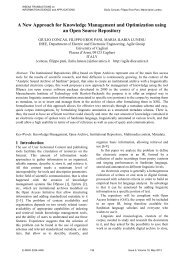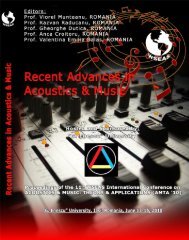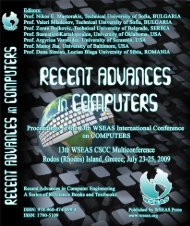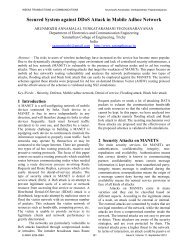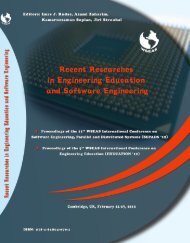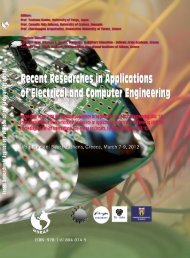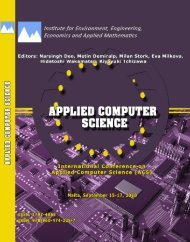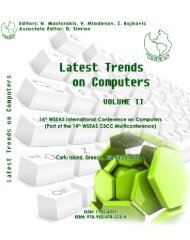LATEST TRENDS on COMPUTERS (Volume I) - Wseas.us
LATEST TRENDS on COMPUTERS (Volume I) - Wseas.us
LATEST TRENDS on COMPUTERS (Volume I) - Wseas.us
- No tags were found...
Create successful ePaper yourself
Turn your PDF publications into a flip-book with our unique Google optimized e-Paper software.
<str<strong>on</strong>g>LATEST</str<strong>on</strong>g> <str<strong>on</strong>g>TRENDS</str<strong>on</strong>g> <strong>on</strong> <strong>COMPUTERS</strong>(<strong>Volume</strong> I)14th WSEAS Internati<strong>on</strong>al C<strong>on</strong>ference <strong>on</strong> <strong>COMPUTERS</strong>(Part of the 14th WSEAS CSCC Multic<strong>on</strong>ference)(<strong>Volume</strong> I)Corfu Island, GreeceJuly 23-25, 2010Recent Advances in Computer EngineeringA Series of Reference Books and TextbooksPublished by WSEAS Presswww.wseas.orgISSN: 1792-4251ISBN: 978-960-474-201-1
<str<strong>on</strong>g>LATEST</str<strong>on</strong>g> <str<strong>on</strong>g>TRENDS</str<strong>on</strong>g> <strong>on</strong> <strong>COMPUTERS</strong>(<strong>Volume</strong> I)14th WSEAS Internati<strong>on</strong>al C<strong>on</strong>ference <strong>on</strong> <strong>COMPUTERS</strong>(Part of the 14th WSEAS CSCC Multic<strong>on</strong>ference)(<strong>Volume</strong> I)Corfu Island, Greece, July 23-25, 2010Recent Advances in Computer EngineeringA Series of Reference Books and TextbooksPublished by WSEAS Presswww.wseas.orgCopyright © 2010, by WSEAS PressAll the copyright of the present book bel<strong>on</strong>gs to the World Scientific and Engineering Academy andSociety Press. All rights reserved. No part of this publicati<strong>on</strong> may be reproduced, stored in a retrievalsystem, or transmitted in any form or by any means, electr<strong>on</strong>ic, mechanical, photocopying, recording, orotherwise, without the prior written permissi<strong>on</strong> of the Editor of World Scientific and Engineering Academyand Society Press.All papers of the present volume were peer reviewed by two independent reviewers. Acceptance wasgranted when both reviewers' recommendati<strong>on</strong>s were positive.See also: http://www.worldses.org/review/index.htmlISSN: 1792-4251ISBN: 978-960-474-201-1World Scientific and Engineering Academy and Society
<str<strong>on</strong>g>LATEST</str<strong>on</strong>g> <str<strong>on</strong>g>TRENDS</str<strong>on</strong>g> <strong>on</strong> <strong>COMPUTERS</strong>(<strong>Volume</strong> I)14th WSEAS Internati<strong>on</strong>al C<strong>on</strong>ference <strong>on</strong> <strong>COMPUTERS</strong>(Part of the 14th WSEAS CSCC Multic<strong>on</strong>ference)(<strong>Volume</strong> I)Corfu Island, GreeceJuly 23-25, 2010
Editors:Prof. Nikos E. Mastorakis, BULGARIAProf. Valeri Mladenov, BULGARIAProf. Zoran Bojkovic, SERBIAAssociate Editor:Prof. Dana Simian, ROMANIAInternati<strong>on</strong>al Program Committee Members:Joseph Sifakis, FRANCELotfi A. Zadeh, USALe<strong>on</strong> O. Chua, USAK. R. Rao, USADimitri Bertsekas, USABiswa N. Datta, USAIrwin Sandberg, USAP. Pardalos, USAA. Manikas, UKT. Kaczorek, POLANDWlodzislaw Duch, POLANDSidney Burr<strong>us</strong>, USALe<strong>on</strong>id G. Kazovsky, USAGeorgios B. Giannakis, USANikolaos G. Bourbakis, USABrian A. Barsky, USARyszard S. Choras, POLANDWasfy B. Mikhael, USAM. Kostic, USAA. Venetsanopoulos, CANADAK. Benra, GERMANYS. Sohrab, USA
PrefaceThis year the 14th WSEAS Internati<strong>on</strong>al C<strong>on</strong>ference <strong>on</strong> <strong>COMPUTERS</strong> (Part of the 14thWSEAS CSCC Multic<strong>on</strong>ference) was held <strong>on</strong> Corfu Island, Greece, July 23-25, 2010. Thec<strong>on</strong>ference remains faithful to its original idea of providing a platform to disc<strong>us</strong>s algorithms andtheory of computati<strong>on</strong>, artificial intelligence, graphics, computer networking, militarycommunicati<strong>on</strong>s, programming languages, fault tolerance, computati<strong>on</strong>al linguistics, algorithmsand multiplexity, microprocessors, microcomputers, mobile computing, intelligent agents,mathematical logic and computers, image, video and internet technologies, web-based educati<strong>on</strong>,modelling and simulati<strong>on</strong> etc. with participants from all over the world, both from academia andfrom ind<strong>us</strong>try.Its success is reflected in the papers received, with participants coming from several countries,allowing a real multinati<strong>on</strong>al multicultural exchange of experiences and ideas.The accepted papers of this c<strong>on</strong>ference are published in this Book that will be indexed by ISI.Please, check it: www.worldses.org/indexes as well as in the CD-ROM Proceedings. They willbe also available in the E-Library of the WSEAS. The best papers will be also promoted in manyJournals for further evaluati<strong>on</strong>.A C<strong>on</strong>ference such as this can <strong>on</strong>ly succeed as a team effort, so the Editors want to thank theInternati<strong>on</strong>al Scientific Committee and the Reviewers for their excellent work in reviewing thepapers as well as their invaluable input and advice.The Editors
<str<strong>on</strong>g>LATEST</str<strong>on</strong>g> <str<strong>on</strong>g>TRENDS</str<strong>on</strong>g> <strong>on</strong> <strong>COMPUTERS</strong> (<strong>Volume</strong> I)Table of C<strong>on</strong>tentsKeynote Lecture 1: Optimizing the Performance of Scientific Java Applicati<strong>on</strong>s 17Kleanthis PsarrisPlenary Lecture 1: Color Pattern Recogniti<strong>on</strong> for Computer Visi<strong>on</strong> <strong>us</strong>ing C<strong>on</strong>versi<strong>on</strong> of theColor Space, Neural Classifiers and Feature/Decisi<strong>on</strong> F<strong>us</strong>i<strong>on</strong>Victor-Emil Neagoe18Plenary Lecture 2: The Maximum Clique Problem 19Etsuji TomitaPlenary Lecture 3: Fault Diameters of Graph Products and Bundles 20Janez ZerovnikPlenary Lecture 4: Interpolati<strong>on</strong> and Design of Geometric Algorithms 21Dana SimianPlenary Lecture 5: Improvement Research Activity Management in Universities, by <strong>us</strong>ing ICTTechnologyMaria MoisePlenary Lecture 6: Semantic Schema: A Graph Based Mechanism for Cooperating Structuresin Knowledge Representati<strong>on</strong>Nicolae Tandareanu2223Plenary Lecture 7: Digital Video Tamper and Forgery Detecti<strong>on</strong> Techniques 24Girija ChettyPlenary Lecture 8: Uncertain Knowledge Expressing and Processing 25Guoyin WangPlenary Lecture 9: Computati<strong>on</strong>ally Recognizing Ca<strong>us</strong>ality in an Imprecise World 26Lawrence J. MazlackPART I 27Characteristics for a New Prec<strong>on</strong>diti<strong>on</strong>er of Linear Systems 29Ran BaikA Study for Eigenvalues Problems of Vibrati<strong>on</strong> Modes <strong>on</strong> Dopplers 34Ran BaikOptimizing Geographical Informati<strong>on</strong> System Data By Using An Agent-Based Approach toData Wareho<strong>us</strong>ingPooya Khosraviyan38A New Way Towards Security in TCP/IP Protocol Suite 46M. Anand Kumar, M. Hemalatha, P. Nagaraj, S. KarthikeyanISSN: 1792-4251 9 ISBN: 978-960-474-201-1
<str<strong>on</strong>g>LATEST</str<strong>on</strong>g> <str<strong>on</strong>g>TRENDS</str<strong>on</strong>g> <strong>on</strong> <strong>COMPUTERS</strong> (<strong>Volume</strong> I)WRL:A Wormhole-Resistent Localizati<strong>on</strong> Scheme Based <strong>on</strong> DV-hop for Wireless SensorNetworksHe R<strong>on</strong>ghui, Ma Guoqing, Fang Lan, Kuang Chunguang, Liu LiResearch <strong>on</strong> Memory Access Vulnerability Analysis Technique in SCADA ProtocolImplementati<strong>on</strong>Fang Lan, Wang Chunlei, He R<strong>on</strong>ghui5157An Integrated eHealth System <strong>us</strong>ing Medical Informati<strong>on</strong> Standards 63Bogdan Orza, Alin Cordos, Aurel Vlaicu, Serban Meza, Bogdan PetrovanEvaluati<strong>on</strong> of Life Cycle Functi<strong>on</strong>ality of Java Platform 69Roman Roelofsen, Arne Koschel, Irina AstrovaTargeting Cells to Switch Assignment of Cellular Mobile Network <strong>us</strong>ing Heuristic Algorithm 75K. Rajalakshmi, Prakash Kumar, Hima M. BinduA Strip-Down Database for Modern Informati<strong>on</strong> Systems 81Khubaib Ahmed Qureshi, Sheikh Mohiuddin, Aziz-Uddin, Atique-Ur-RehmanA Software Method for Managing Event Logs to Improve Quality and Dependability ofB<strong>us</strong>iness ProcessesMehmet S. Unluturk, Kaan Kurtel89Host Frame User Interface and its Architecture 95Mehmet S. Unluturk, Kaan Kurtel, Coskun AtayN<strong>on</strong> Axysimmetrical Stability Study of Swirling Flows Using a Projecti<strong>on</strong> Algorithm 103Diana Alina Bistrian, George SaviiApplicati<strong>on</strong> of Neural Networks to Damage Classificati<strong>on</strong> in Composite Structures 109Mahmoud Z. IskandaraniHigh Performance Parallel Computing for FDTD Numerical Technique in ElectromagneticCalculati<strong>on</strong>s for SAR Distributi<strong>on</strong> Inside Human HeadHesham Eldeeb, Hala Elsadek, Maha Dessokey, Haytham Abdallah, Nader Bagherzadeh114The Determinati<strong>on</strong> of the Guillotine Restricti<strong>on</strong>s for a Rectangular Cutting-Stock Pattern 121Daniela Marinescu, Alexandra BaicoianuOn the Use of Higher Frame Rate in the Training Phase of ASR 127Darko Pekar, Niksa Jakovljevic, Marko Janev, Dragisa Miskovic, Vlado DelicUsing Typed Messages and Message Filters for the Realizati<strong>on</strong> of Pervasive Applicati<strong>on</strong>s 131Agostino PoggiXML Cl<strong>us</strong>tering by Bit Vector 137Woosaeng KimAll Minimum Flows in Networks 143Laura Ciupala, Ele<strong>on</strong>or CiureaMetamorphic Vir<strong>us</strong> Variants Classificati<strong>on</strong> Using Opcode Frequency Histogram 147Babak Bashari Rad, Maslin MasromISSN: 1792-4251 10 ISBN: 978-960-474-201-1
<str<strong>on</strong>g>LATEST</str<strong>on</strong>g> <str<strong>on</strong>g>TRENDS</str<strong>on</strong>g> <strong>on</strong> <strong>COMPUTERS</strong> (<strong>Volume</strong> I)Time Series Predicti<strong>on</strong> of Web Domain Visits by IF-Inference System 156Vladimir Olej, Jana Filipova, Petr HajekLocal S<strong>us</strong>tainable Development Modelling by Hierarchical IF-Inference Systems 162Petr Hajek, Vladimir OlejFuzzy Identity Authenticati<strong>on</strong> 168Nicolae C<strong>on</strong>stantinescu, I<strong>on</strong> IancuCalibrating C<strong>on</strong>ceptual Rainfall-Runoff Models Using a Real Genetic Algorithm Combinedwith a Local Search MethodA. R Awad, I. V<strong>on</strong> Poser174A Generalizati<strong>on</strong> of Some Integral Equati<strong>on</strong>s 182Maria Dobritoiu, Ana-Maria DobritoiuEquilateral-Triangle Mesh for Optimal Micrositing of Wind Farms 187Xiaolan Li, Jun Wang, Xing ZhangAdaptive Processing of Bioelectric Abdominal Signals to Improve the Reliability of Fetal HomeTelem<strong>on</strong>itoringTomasz Kupka, Jan<strong>us</strong>z Jezewski, Adam Mat<strong>on</strong>ia, Dawid Roj, Krzysztof HorobaInfluence of Input Data Modificati<strong>on</strong> of Neural Networks Applied to the Fetal OutcomeClassificati<strong>on</strong>Michal Jezewski, Robert Czabanski, Dawid Roj, Jan<strong>us</strong>z Wrobel196202A C<strong>on</strong>current Neural Module Classifier for Automated Target Recogniti<strong>on</strong> in SAR Imagery 208Victor-Emil Neagoe, Daniel-Cris Cara<strong>us</strong>u, Gabriel-Eduard StrugaruA Multi-Agent Approach for Distributed Knowledge Processing in C<strong>on</strong>tact Centers 214Claudiu I<strong>on</strong>ut PopirlanA Spoken Questi<strong>on</strong> Answering System Based <strong>on</strong> C<strong>on</strong>diti<strong>on</strong>al Knowledge 220Nicolae Tandareanu, Mihaela Colh<strong>on</strong>, Cristina ZamfirBalancing Algorithm for the Minimum Flow Problem in Parametric Bipartite Networks 226Ele<strong>on</strong>or Ciurea, Mircea ParpaleaInvariant Object Representati<strong>on</strong> with Modified Mellin-Fourier Transform 232Roumen Kountchev, Vladimir Todorov, Roumiana KountchevaAuthenticati<strong>on</strong> Hierarchy in Distributed Deductive Databases 238Dorel Savulea, Nicolae C<strong>on</strong>stantinescuWiimote-based Aid Tool for On-line Visual Presentati<strong>on</strong>s 244Mari<strong>us</strong>-Gavril LupouTransfomati<strong>on</strong> of N<strong>on</strong>-feasible Inverse Maximum Flow Problem into a Feasible <strong>on</strong>e by FlowModificati<strong>on</strong>Adrian Deac<strong>on</strong>u, Ele<strong>on</strong>or Ciurea, Corneliu MarinescuLegal Implicati<strong>on</strong>s of Accessing and <strong>us</strong>ing Informati<strong>on</strong> Technology. Legislati<strong>on</strong> in Romaniaand in the EUAndreea Ciurea250256ISSN: 1792-4251 11 ISBN: 978-960-474-201-1
<str<strong>on</strong>g>LATEST</str<strong>on</strong>g> <str<strong>on</strong>g>TRENDS</str<strong>on</strong>g> <strong>on</strong> <strong>COMPUTERS</strong> (<strong>Volume</strong> I)Modern Methods of Research in Legal Educati<strong>on</strong> <strong>us</strong>ing Informati<strong>on</strong> Technology 261Andreea CiureaA New Neural Network Approach for Visual Aut<strong>on</strong>omo<strong>us</strong> Road Following 266Cristian-Tudor Tudoran, Victor-Emil NeagoeCompositi<strong>on</strong>al Verificati<strong>on</strong> with Stutter-invariant Propositi<strong>on</strong>al Projecti<strong>on</strong> Temporal Logic 272Chen Yang, Zhenhua DuanIPT Framework: A Technical & Administrative Approach for IP Packets Traceback andIdentifying Cyber CriminalsAbolfazl Amirkhan, Davood Vahdat, Nasrollah Moghaddam Cherkari281C<strong>on</strong>siderati<strong>on</strong> <strong>on</strong> MAS as a Basis for Distributed Modeling of Urban Traffic Simulati<strong>on</strong> 288Alexandru Cicortas, Victoria Iordan, Antoanela Naaji, M<strong>on</strong>ica Ciobanu, Norbert SomosiAn Approach for C<strong>on</strong>textual Translati<strong>on</strong> based <strong>on</strong> Semantic Schemas 294Mihaela Colh<strong>on</strong>, Nicolae TandareanuImprovement of Handoff in MobileWiMAX Networks Using Mobile Agents 300Gabriel StoianSecurity and Performance Trade-Off in KILAVI Wireless Sensor Network 306Mikael Soini, Juha Kukkurainen, Lauri SydanheimoTowards Flexible Database C<strong>on</strong>versi<strong>on</strong> with Automatic Restructuring 314Siti Z. Z. Abidin, Suzana Ahmad, Wael M. S. YafoozImplementati<strong>on</strong> of Smart Tags of RFID Technology in Pois<strong>on</strong>o<strong>us</strong> Area 320Davood Karimzadgan Moghaddam, Davood Vahdat, Pejman RavandMunicipal Revenue Predicti<strong>on</strong> by Support Vector Machine Ensembles 325Petr Hajek, Vladimir OlejThe Relative Thermodynamic Stability of Base Stacking in Pyrimidine / Purine Dinucleotides 331Nigel AylwardSimulati<strong>on</strong> of Water Hammer Phenomen<strong>on</strong> in a Pumping Discharge Duct Protected by Air 338Anca C<strong>on</strong>stantin, Claudiu Stefan NitescuThe Analysis of a Faster Algorithm for Support Vector Machine-based Classificati<strong>on</strong> 342Luminita State, Iuliana Paraschiv-MunteanuPerformance Evaluati<strong>on</strong> of OpenMP Benchmarks <strong>on</strong> Intel's Quad Core Processors 348Jareer H. Abdel-Qader, Roger S. WalkerModeling Real-Time Tolapai Based Embedded System <strong>us</strong>ing MARTE 356Jareer H. Abdel-Qader, Roger S. WalkerModel of Software System for Automatic Corn Kernels F<strong>us</strong>arium (spp.) Disease Diagnostics 362Tsvetelina Draganova, Plamen Daskalov, R<strong>us</strong>in Ts<strong>on</strong>evEfficient Structured Log Storage 368Pavel KachaISSN: 1792-4251 12 ISBN: 978-960-474-201-1
<str<strong>on</strong>g>LATEST</str<strong>on</strong>g> <str<strong>on</strong>g>TRENDS</str<strong>on</strong>g> <strong>on</strong> <strong>COMPUTERS</strong> (<strong>Volume</strong> I)Using Fuzzy Techniques for Students' Evaluati<strong>on</strong> 375Eugene Roventa, Antoanela Naaji, Ioan DascalA Novel Framework for the cOMPOsiti<strong>on</strong> of Schema Matchers 379Balazs Villanyi, Peter Martinek, Bela SzikoraLanguage-Independent Generati<strong>on</strong> of Logic Representati<strong>on</strong>s for Programs 385Calin Jebelean, Ciprian-Bogdan Chirila, Tit<strong>us</strong> Slavici, Vladimir CretuFace Detecti<strong>on</strong> Using a Dual Cross-Validati<strong>on</strong> of Chrominance/Luminance Channel Decisi<strong>on</strong>sand Decorrelati<strong>on</strong> of the Color SpaceVictor-Emil Neagoe, Mihai Neghina391Socio-Informatics: Identifying Influential Factors in Digital Elements 397Siti Z. Z. Abidin, Nasiroh Omar, Hani F. A. Rahman, Marshima M. RosliImproved Structuring Element for Handwriting and Hand Printed Characters Skelet<strong>on</strong> 403Dan L. Lacrama, Florin AlexaPART II 409Calculati<strong>on</strong> of the Accelerati<strong>on</strong> of Parallel Programs as a Functi<strong>on</strong> of the Number of Threads 411George Popov, Nikos Mastorakis, Valeri MladenovData Wareho<strong>us</strong>e for an e-Learning Platform 415Zoran Nebic, Viljan MahnicApplicati<strong>on</strong> of Statistical Process C<strong>on</strong>trol in Defined Level Software Companies to ManageProcesses Using C<strong>on</strong>trol Charts with Three SigmaG. Vijaya, S. Arumugam421On a Remarkable Transformati<strong>on</strong>s Group 428M<strong>on</strong>ica A. P. Purcaru, Mirela Tarnoveanu, Laura CiupalaTowards a Deterministic Model for Course Timetabling 434Pilar Pozos Parra, Oscar Chavez Bosquez, Jose Luis Gomes RamosEnhanced Artificial Bee Col<strong>on</strong>y Algorithm Performance 440Nadezda Stanarevic, Milan Tuba, Nebojsa BacaninLexico-Syntactic Ca<strong>us</strong>al Pattern Text Mining 446S<strong>on</strong>ali Joshi, Manali Panga<strong>on</strong>kar, Swathi Seethakkagari, Lawrence J. MazlackAccuracy Estimati<strong>on</strong> in Approximate Query Processing 452Carlo Dell’Aquila, Francesco Di Tria, Ezio Lef<strong>on</strong>s, Filippo TangorraRecent Advancements in Biometrics: Vein and Fingerprint Authenticati<strong>on</strong> 459Hatim A. AboalsamhElectr<strong>on</strong>ic Tool for Analysis of Employees' Feedback 463Kostadinka Toteva, Elissaveta GourovaDual Variati<strong>on</strong>al Principle for a Problem of Heat C<strong>on</strong>ducti<strong>on</strong> in a Rectangular Plate 469Mioara B<strong>on</strong>cut, Dumitru BaracISSN: 1792-4251 13 ISBN: 978-960-474-201-1
<str<strong>on</strong>g>LATEST</str<strong>on</strong>g> <str<strong>on</strong>g>TRENDS</str<strong>on</strong>g> <strong>on</strong> <strong>COMPUTERS</strong> (<strong>Volume</strong> I)Statistical Analysis of Signature Features with Respect to Applicability in Off-line SignatureVerificati<strong>on</strong>Bence Kovari, Hassan Charaf473Auditory-Verbal Educati<strong>on</strong> for Hearing Impaired Children Using Internet-Based Technologies 479Ovidiu Grigore, Valentin Velican, Alexandra CraciunoiuNew Hash Functi<strong>on</strong> C<strong>on</strong>structi<strong>on</strong> for Textual and Geometric Data Retrieval 483Vaclav Skala, Jan Hradek, Martin KucharA Novel Virtual Potential Field Transform for Gray-scale Images Inspired by Physical ElectrostaticFieldX. D. Zhuang, N. E. MastorakisUML Design of a System for Coordinated Care of Mentally Ill Patients after Discharge toHomeVasilios Christou, Maria Polizou, Vasilios Apostolopoulos, Andriana Prentza490499Fuzzy Set-based Distant Cl<strong>us</strong>ter Identificati<strong>on</strong> 506Ke<strong>on</strong> Myung Lee, Sun A. LeeC<strong>on</strong>cept Hierarchy_based Cube Aggregati<strong>on</strong> for ETL Process in Matriculati<strong>on</strong> Wareho<strong>us</strong>e 510Zar Ni MgModeling and Simulati<strong>on</strong> of a Team Game with Coloured Petri Nets 516Marin Popa, Mihaita Dragan, Mariana PopaSystematic Hydraulic Study <strong>on</strong> Pumping Stati<strong>on</strong>s Equipped with Surge Tank Mounted next tothe PumpClaudiu Stefan Nitescu, Anca C<strong>on</strong>stantin521Interactive Envir<strong>on</strong>ment for Comparative Analysis of Sequential and Parallel Algorithms 527Manuela Panoiu, I<strong>on</strong>el M<strong>us</strong>calagiu, Cai<strong>us</strong> Panoiu, Maria RaichThe Evaluati<strong>on</strong> of the Asynchr<strong>on</strong>o<strong>us</strong> Search Techniques in DisCSP-NetLogo 533I<strong>on</strong>el M<strong>us</strong>calagiu, Manuela Panoiu, Diana Maria M<strong>us</strong>calagiu, Cai<strong>us</strong> PanoiuDesigning an Incremental Cellular Manufacturing System Based <strong>on</strong> Heuristic Methods 539J. Rezaeian, N. JavadianA New Method for M<strong>us</strong>ical Onset Detecti<strong>on</strong> in Polyph<strong>on</strong>ic Piano M<strong>us</strong>ic 545Giovanni Costantini, Massimiliano Todisco, Giovanni SaggioEnhancement of Fog Degraded Images <strong>on</strong> the Basis of Histrogram Classificati<strong>on</strong> 549Raghvendra Yadav, Manoj AlwaniIntegrated Intelligent Modeling, Simulati<strong>on</strong> and Design of Experiments for Software TestingProcessLjubomir Lazic, Nikos E. Mastorakis555A Hardware-Implementable System for Retinal Vessel Segmentati<strong>on</strong> 568Giovanni Costantini, Daniele Casali, Massimiliano TodiscoAn SVM based Method for Associative Memories 574Daniele Casali, Giovanni Costantini, Massimiliano TodiscoISSN: 1792-4251 14 ISBN: 978-960-474-201-1
<str<strong>on</strong>g>LATEST</str<strong>on</strong>g> <str<strong>on</strong>g>TRENDS</str<strong>on</strong>g> <strong>on</strong> <strong>COMPUTERS</strong> (<strong>Volume</strong> I)Verifying OWL Ontology Correctness Using Max-Heaps 579Ethan White, Lawrence MazlackMeasuring the Degree of Similarity Between Web Ontologies based <strong>on</strong> Semantic Coherence 584Abhik Banerjee, Hareendra Munimadugu, Srinivasa Raghavan Vedanarayanan, Lawrence J.MazlackEvaluati<strong>on</strong> of Hurst Exp<strong>on</strong>ent for Precipitati<strong>on</strong> Time Series 590Alina Barbulescu, Cristina Serban, Carmen MafteiEstimati<strong>on</strong> of Evapotranspirati<strong>on</strong> Using Remote Sensing Data and Grid Computing: A CaseStudy in Dobrogea, RomaniaCristina Serban, Carmen Maftei, Alina BarbulescuA Stereospecific Synthesis of Pantothenic Acid Derivatives in Prebiotic Molecular Evoluti<strong>on</strong> <strong>on</strong>EarthNigel Aylward596602Representing Lexical Knowledge for Bulgarian Inflecti<strong>on</strong>al Morphology in DATR 612Velislava StoykovaMinimizing the Repository <strong>Volume</strong> for Spent Nuclear Fuel 617Gasper Zerovnik, Janez ZerovnikANN Approach for the Document Cl<strong>us</strong>tering By Using Evoluti<strong>on</strong>ary Computati<strong>on</strong> 623Shutan Hsieh, Ching-L<strong>on</strong>g Su, Jeffrey LiawUsing CPSO for the Engineering Optimizati<strong>on</strong> Problems 630Ching-L<strong>on</strong>g Su, Shutan HsiehEdge Fault-Diameter of Graph Product 636Janez ZerovnikFault Diameters of Graph Products and Bundles 642Janez ZerovnikImprovement Research Activity Management in Universities, by <strong>us</strong>ing ICT Technology 652Maria MoiseUser Behavior <strong>on</strong> Web Applicati<strong>on</strong>s for Decisi<strong>on</strong>-Oriented Maintenance 658Gabriel Eugen Garais, Maria MoiseThe Usage of Linear Regressi<strong>on</strong> Models in Predictive Microbiology 665Despa Radu, Folcut Ovidiu, Cristina CoculescuEcotourism B<strong>us</strong>iness Models 669Cezar Mihalcescu, Daniela Firoiu, Beatrice Si<strong>on</strong>, Cristina ManiuDesign and Performance Evaluati<strong>on</strong> of Snow Cover Computing <strong>on</strong> GPUs 674Ladislav Huraj, Vladimir Siladi, Jozef SilaciAdaptive Technique of Impulsive Noise Removal in Color Images 678Bogdan SmolkaISSN: 1792-4251 15 ISBN: 978-960-474-201-1
<str<strong>on</strong>g>LATEST</str<strong>on</strong>g> <str<strong>on</strong>g>TRENDS</str<strong>on</strong>g> <strong>on</strong> <strong>COMPUTERS</strong> (<strong>Volume</strong> I)SOA Approach to Municipal E-Services 684Rumen Trif<strong>on</strong>ov, Tasho TashevDesktop Applicati<strong>on</strong> with Internet Access for the Administrati<strong>on</strong> of the Human Resources andLogistics of an Instituti<strong>on</strong>Livia Sangeorzan, Daniela Cristina Stoicescu, Kinga Kiss Iakab687The Impact of Electr<strong>on</strong>ic Communicati<strong>on</strong> Technology <strong>on</strong> Teamwork 693Cristina Raulea, Ciprian RauleaModeling the Broker Behavior Using a BDI Agent 699Laura Florentina Cacovean, Florin StoicaAn Evoluti<strong>on</strong>ary Approach for Optimizing Stochastic Learning Automata 704Florin Stoica, Laura Florentina CacoveanShape Design Comp<strong>on</strong>ent of a Strain-Stress Analysis System 710Dana Simian, Corina SimianOn a New Approach to Obtain Spline Bezier Curves 716Dana SimianThe Geometry of Language – a Space Semantic Network of Bulgarian Nominal Inflecti<strong>on</strong>alMorphologyVelislava Stoykova, Chavdar Lozanov721A Mobile Patient M<strong>on</strong>itoring System Using RFID 726Ilker Korkmaz, Coskun Atay, George KyparisisA Self-Organized Neuro-Fuzzy System for Stock Market Dynamics Modeling and Forecasting 733C. L. Su, C. J. Chen, S. M. YangMatlab - Octave Science and Engineering Benchmarking and Comparis<strong>on</strong> 746A. P. Leros, A. Andreatos, A. ZagorianosGESKEE Database – an Innovative Tool for Seismic Risk Assessment and Loss Scaling 755Cosmin Filip, Cristina Serban, Mirela Popa, Gabriela DraghiciAsymptotic State of One-Dimensi<strong>on</strong>al SOM at Normal Point Density Input Passed throughN<strong>on</strong>-Linear ChannelIvo R. Draganov, Antoaneta A. Popova, Nikolay N. Neshov761Towards Integrated Electr<strong>on</strong>ic Services in Public Sector 766Seppo SirkemaaThe Role of Tr<strong>us</strong>t in e-B<strong>us</strong>iness: Understanding the C<strong>us</strong>tomer 771Seppo SirkemaaA Study <strong>on</strong> Impact Factors of the Adopti<strong>on</strong> of Informati<strong>on</strong> Systems in the Operating Room 776M. F. Santos, L. GomesPerformance Analysis and Comparis<strong>on</strong> of Virtualizati<strong>on</strong> Protocols, RDP and PCoIP 782Jiri Kouril, Petra LambertovaAuthors Index 788ISSN: 1792-4251 16 ISBN: 978-960-474-201-1
<str<strong>on</strong>g>LATEST</str<strong>on</strong>g> <str<strong>on</strong>g>TRENDS</str<strong>on</strong>g> <strong>on</strong> <strong>COMPUTERS</strong> (<strong>Volume</strong> I)Keynote Lecture 1Optimizing the Performance of Scientific Java Applicati<strong>on</strong>sProfessor Kleanthis PsarrisDepartment of Computer ScienceThe University of Texas at San Ant<strong>on</strong>ioSan Ant<strong>on</strong>io, TX 78249USAE-mail: psarris@cs.utsa.eduAbstract: As part of its type-safety regime, the Java semantics require precise excepti<strong>on</strong> at runtime when programsattempt out-of-bound array accesses. In general, this requires a dynamic bounds check each time an array element isaccessed, which limits the performance of array intensive scientific applicati<strong>on</strong>s implemented in Java. However, if itcan be proven that the array index is within the bounds of the array, the check can be eliminated. We present a newalgorithm based <strong>on</strong> extended Static Single Assignment (eSSA) form that builds a c<strong>on</strong>straint system representingc<strong>on</strong>trol flow qualified, linear c<strong>on</strong>straints am<strong>on</strong>g program variables derived from program statements. Our system thenderives relati<strong>on</strong>ships am<strong>on</strong>g variables, and provides a verifiable proof of its c<strong>on</strong>cl<strong>us</strong>i<strong>on</strong>s. This proof can be verified bya runtime system to minimize the analysis’ performance impact. Our system simultaneo<strong>us</strong>ly c<strong>on</strong>siders both c<strong>on</strong>trolflow and data flow when analyzing the c<strong>on</strong>straint system, handles general linear inequalities instead of simpledifference c<strong>on</strong>straints, and provides verifiable proofs for its claims. We present experimental results dem<strong>on</strong>stratingthat this method eliminates more bounds checks than prior approaches with minimal overhead during JIT compilati<strong>on</strong>.Furthermore our algorithm increased the speed at which the Java benchmarks executed by up to 16%.Brief Biography of the Speaker:Kleanthis Psarris is Professor and Chair of the Department of Computer Science at the University of Texas at SanAnt<strong>on</strong>io. He received his B.S. degree in Mathematics from the Nati<strong>on</strong>al University of Athens, Greece in 1984. Hereceived his M.S. degree in Computer Science in 1987, his M.Eng. degree in Electrical Engineering in 1989 and hisPh.D. degree in Computer Science in 1991, all from Stevens Institute of Technology in Hoboken, New Jersey. Hisresearch interests are in the areas of Parallel and Distributed Systems, Programming Languages and Compilers, andHigh Performance Computing. He has designed and implemented state of the art program analysis and compileroptimizati<strong>on</strong> techniques and he developed compiler tools to increase program parallelizati<strong>on</strong> and improve executi<strong>on</strong>performance <strong>on</strong> advanced computer architectures. He has published extensively in top journals and c<strong>on</strong>ferences inthe field and his research has been funded by the Nati<strong>on</strong>al Science Foundati<strong>on</strong> and Department of Defenseagencies. He is an Editor of the Parallel Computing journal. He has served <strong>on</strong> the Program Committees of severalinternati<strong>on</strong>al c<strong>on</strong>ferences including the ACM Internati<strong>on</strong>al C<strong>on</strong>ference <strong>on</strong> Supercomputing (ICS) in 1995, 2000, 2006and 2008, the IEEE Internati<strong>on</strong>al C<strong>on</strong>ference <strong>on</strong> High Performance Computing and Communicati<strong>on</strong>s (HPCC) in2008, 2009, and 2010, and the ACM Symposium <strong>on</strong> Applied Computing (SAC) in 2003, 2004, 2005 and 2006.ISSN: 1792-4251 17 ISBN: 978-960-474-201-1
<str<strong>on</strong>g>LATEST</str<strong>on</strong>g> <str<strong>on</strong>g>TRENDS</str<strong>on</strong>g> <strong>on</strong> <strong>COMPUTERS</strong> (<strong>Volume</strong> I)Plenary Lecture 1Color Pattern Recogniti<strong>on</strong> for Computer Visi<strong>on</strong> <strong>us</strong>ing C<strong>on</strong>versi<strong>on</strong> of the Color Space,Neural Classifiers and Feature/Decisi<strong>on</strong> F<strong>us</strong>i<strong>on</strong>Professor Victor-Emil NeagoeDepartment of Electr<strong>on</strong>ics, Telecommunicati<strong>on</strong>s, and Informati<strong>on</strong> TechnologyPolytechnic University of BucharestROMANIAE-mail: victoremil@gmail.comAbstract: This lecture is an approach dedicated to the improvement of color pattern recogniti<strong>on</strong> performances forcomputer visi<strong>on</strong>. Like humans, the artificial intelligence systems <strong>us</strong>e color for pattern recogniti<strong>on</strong>. There are a lot ofsystems for pictorial c<strong>on</strong>tent representati<strong>on</strong> and recogniti<strong>on</strong> based <strong>on</strong> color features. First secti<strong>on</strong> is dedicated to theevaluati<strong>on</strong> of the color spaces for computer visi<strong>on</strong>. One c<strong>on</strong>siders the c<strong>on</strong>versi<strong>on</strong> from the c<strong>on</strong>venti<strong>on</strong>al RGB spaceinto a color space with improved pattern recogniti<strong>on</strong> performances. In the sec<strong>on</strong>d secti<strong>on</strong>, we present the model ofC<strong>on</strong>current Neural Classifiers (CNC) representing a collecti<strong>on</strong> of small neural networks, which <strong>us</strong>e a global winnertakes-allstrategy. Each neural module is trained to correctly classify the patterns of <strong>on</strong>e class <strong>on</strong>ly and the number ofmodules equals the number “M” of classes. One c<strong>on</strong>siders the case of choosing the SOM (Self-Organized-Map) as aneural module. We built “M” training pattern sets and each neural module is trained with the pattern set characterizedby the corresp<strong>on</strong>ding class label. Third secti<strong>on</strong> has as theme data f<strong>us</strong>i<strong>on</strong> for color pattern recogniti<strong>on</strong> as an emergingtechnology with significant advantages over simple source data . We c<strong>on</strong>sider data f<strong>us</strong>i<strong>on</strong> and feature f<strong>us</strong>i<strong>on</strong> for thechannels of the c<strong>on</strong>sidered color space. Fourth secti<strong>on</strong> is dedicated to the special technique of pattern recogniti<strong>on</strong>called decisi<strong>on</strong> f<strong>us</strong>i<strong>on</strong>, by combining the classificati<strong>on</strong> powers of several classifiers. The combinati<strong>on</strong> functi<strong>on</strong> shouldtake advantage of the strengths of the individual classifiers, avoid their weaknesses, and improve classificati<strong>on</strong>accuracy. We present the experimental results of our approach for color pattern recogniti<strong>on</strong> in the fields of biometricsand robotics.Brief Biography of the Speaker:Dr. Victor-Emil Neagoe is a Professor of the Department of Electr<strong>on</strong>ics, Telecommunicati<strong>on</strong>s, and Informati<strong>on</strong>Technology at the Polytechnic University of Bucharest, Romania.He teaches the following courses : Pattern Recogniti<strong>on</strong> and Artificial Intelligence; Digital Signal Processing;Computati<strong>on</strong>al Intelligence ; Detecti<strong>on</strong> and Estimati<strong>on</strong> for Informati<strong>on</strong> Processing. He co-ordinates 10 Ph.D.candidates.His research interest corresp<strong>on</strong>ds to the fields of pattern recogniti<strong>on</strong>, computati<strong>on</strong>al intelligence, biometrictechnology , satellite image analysis and sampling theory. Prof. Neagoe is author of more than 120 publishedpapers.His has internati<strong>on</strong>ally recognized results c<strong>on</strong>cerning c<strong>on</strong>current self-organized maps, face recogniti<strong>on</strong>,optimum color c<strong>on</strong>versi<strong>on</strong>, syntactical self-organized maps, n<strong>on</strong>uniform sampling theorems, inversi<strong>on</strong> of the Van derM<strong>on</strong>de matrix, predictive ordering and linear approximati<strong>on</strong> for image data compressi<strong>on</strong>, Legendre descriptors forclassificati<strong>on</strong> of polyg<strong>on</strong>al closed curves.He has been included in Who’s Who in the World and Europe 500 and he has been nominated by the AmericanBiographical Institute for American Medal of H<strong>on</strong>or and for World Medal of H<strong>on</strong>or. He has been a Member IEEE since1978 and a Senior Member IEEE since 1984. He has been a plenary speaker for several WSEAS c<strong>on</strong>ferences since2006 till 2009.ISSN: 1792-4251 18 ISBN: 978-960-474-201-1
<str<strong>on</strong>g>LATEST</str<strong>on</strong>g> <str<strong>on</strong>g>TRENDS</str<strong>on</strong>g> <strong>on</strong> <strong>COMPUTERS</strong> (<strong>Volume</strong> I)Plenary Lecture 2The Maximum Clique ProblemProfessor Etsuji TomitaAdvanced Algorithms Research LaboratoryDepartment of Informati<strong>on</strong> and Communicati<strong>on</strong> EngineeringThe University of Electro-Communicati<strong>on</strong>sTokyo, JAPANE-mail: tomita@ice.uec.ac.jpAbstract: A clique is a subgraph in which all pairs of vertices are mutually adjacent. A maximum clique is a clique ofthe maximum size. Th<strong>us</strong>, a maximum clique stands for a maximum collecti<strong>on</strong> of objects which are mutually related insome specified criteri<strong>on</strong>.The so called maximum clique problem, or the complementary problem, the maximum independent set problem, is<strong>on</strong>e of the original 21 problems shown to be NP-complete by R. Karp. Therefore, it is str<strong>on</strong>gly believed that themaximum clique problem is not solvable easily, i.e., it is not solvable in polynomial-time. Nevertheless, much workhas been d<strong>on</strong>e <strong>on</strong> this problem, experimentally and theoretically. It attracts much attenti<strong>on</strong> especially recently since ithas found many practical applicati<strong>on</strong>s.In this lecture, we are c<strong>on</strong>cerned with recent progress of efficient algorithms for finding a maximum clique. We foc<strong>us</strong><strong>on</strong> branch-and-bound algorithms in which appropriate bounding c<strong>on</strong>diti<strong>on</strong> is most crucial. The step-by-stepimprovements <strong>on</strong> the bounding c<strong>on</strong>diti<strong>on</strong> and their effectiveness are presented. Some algorithms for generating allmaximal cliques are also shown. We give evaluati<strong>on</strong>s <strong>on</strong> these algorithms not <strong>on</strong>ly experimentally but alsotheoretically. We also give a natural c<strong>on</strong>diti<strong>on</strong> in which the maximum clique problem can be proved to be polynomialtimesolvable.In additi<strong>on</strong>, we address successful applicati<strong>on</strong>s of these algorithms to bioinformatics, image processing, data mining,and others.Brief Biography of the Speaker:Etsuji Tomita received his B. Eng. and Dr. Eng. degrees in Electr<strong>on</strong>ics Engineering from Tokyo Institute ofTechnology, Japan, in 1966 and 1971, respectively. Then he was with the faculties of Tokyo Institute of Technology,and was appointed Associate Professor and subsequently Professor at the University of Electro-Communicati<strong>on</strong>s,Japan. Since 2008, he has been Professor Emerit<strong>us</strong> at the University of Electro-Communicati<strong>on</strong>s and Professor atthe Research and Development Initiative of Chuo University. He also teaches at Hokkaido University as a part-timelecturer. He served as the Head of the department of Informati<strong>on</strong> and Communicati<strong>on</strong> Engineering, and the Head ofthe Advanced Algorithms Research Laboratory at UEC.His research interests include design and analysis of computer algorithms, combinatorial optimizati<strong>on</strong> and itsapplicati<strong>on</strong> to practical problems, algorithmic learning theory, and theory of automata and formal languages.His academic c<strong>on</strong>tributi<strong>on</strong>s include Editor of IEICE (Institute of Electr<strong>on</strong>ics, Informati<strong>on</strong> and Communicati<strong>on</strong>Engineers) and Editor-in-Chief of IPSJ (Informati<strong>on</strong> processing Society of Japan), Local Arrangement Chair of ALT(Algorithmic Learning Theory), Chair of SIG Mathematical Modeling and Problem Solving of IPSJ, ProgramCommittee Chair of ALT 2005, and he served as a Guest Editor of Theoretical Computer Science, C<strong>on</strong>ference Chairof ICGI (Internati<strong>on</strong>al Colloquium <strong>on</strong> Grammatical Inference) 2006, Director of IPSJ, Chair of Computer ScienceDomain of IPSJ, and Councilor of JSAI (The Japanese Society for Artificial Intelligence). He is presently a member ofSteering Committee of ICGI.He was given the Y<strong>on</strong>ezawa Award of IECE, the Funai Informati<strong>on</strong> Technology Prize, and the C<strong>on</strong>tributi<strong>on</strong> Award ofSIG MPS of IPSJ, and is presently a Fellow of IEICE and IPSJ.He is a co-author of two papers that were given Yamashita Research Award of IPSJ, and of a paper that was givenEncouraging Award of Computer Science Domain of IPSJ.ISSN: 1792-4251 19 ISBN: 978-960-474-201-1
<str<strong>on</strong>g>LATEST</str<strong>on</strong>g> <str<strong>on</strong>g>TRENDS</str<strong>on</strong>g> <strong>on</strong> <strong>COMPUTERS</strong> (<strong>Volume</strong> I)Plenary Lecture 3Fault Diameters of Graph Products and BundlesProfessor Janez ZerovnikUniversity of Ljubljana, Askerceva 6SI-1000 Ljubljana, SloveniaE-mail: janez.zerovnik@imfm.uni-lj.siAbstract:Brief Biography of the Speaker:Janez Zerovnik received the B.S. and M.S. degree in mathematics from University of Ljubljana, Slovenia. In 1992 hereceived Ph.D. degree in Computer Science from University of Ljubljana and in 1994 Ph.D. degree in mathematicsfrom Technical University Graz, A<strong>us</strong>tria. He is author or coauthor of over 80 journal articles and over 80 c<strong>on</strong>tributi<strong>on</strong>sin refereed c<strong>on</strong>ference proceedings, and wrote five textbooks for undergraduate students. Currently, he is Professorof mathematics at the Faculty of Mechanical Engineering at University of Ljubljana and part time researcher at theInstitute of Mathematics, Physics and Mechanics. His research interests include discrete mathematics, in particulargraph theory and its applicati<strong>on</strong>s in computer science, operati<strong>on</strong>al research, mathematical chemistry, etc.ISSN: 1792-4251 20 ISBN: 978-960-474-201-1
<str<strong>on</strong>g>LATEST</str<strong>on</strong>g> <str<strong>on</strong>g>TRENDS</str<strong>on</strong>g> <strong>on</strong> <strong>COMPUTERS</strong> (<strong>Volume</strong> I)Plenary Lecture 4Interpolati<strong>on</strong> and Design of Geometric AlgorithmsProfessor Dana SimianFaculty of SciencesUniversity Lucian Blaga of SibiuRomaniaE-mail: dana.simian@ulbsibiu.roAbstract: The aim of this talk is to present different interpolati<strong>on</strong> schemes and their applicati<strong>on</strong>s in the geometricaldesign of algorithms. Theoretical and computati<strong>on</strong>al aspects are disc<strong>us</strong>sed. We introduce new interpolati<strong>on</strong> schemesand compare with the classical <strong>on</strong>es. Our interest is to obtain curves and surfaces of class Gk, satisfying givenc<strong>on</strong>straints and to visualize them. The implementati<strong>on</strong> of the algorithms is made in MATLAB envir<strong>on</strong>ment. Wedevelop new functi<strong>on</strong>s and analyze their performance.Brief Biography of the Speaker:Dana Simian received the diploma. in engineering from the University of Sibiu, Romania, the diploma. in Mathematics- Informatics from the University Babes-Bolyai of Cluj-Napoca, Romania and the Ph.D. from Babes-Bolyai Universityof Cluj- Napoca, Romania. She graduated many courses in Computer Science. She is the head of the Department ofComputer Science from the Faculty of Sciences, University Lucian Blaga of Sibiu, Romania. She has a greatexperience in algorithms and numerical methods for modelling and optimizati<strong>on</strong>. She published 16 books, more than60 articles and participated in the editorial board of more than 22 scientific publicati<strong>on</strong>s (proceedings of internati<strong>on</strong>alc<strong>on</strong>ferences).She organized 7 special sessi<strong>on</strong>s within WSEAS c<strong>on</strong>ferences, 2 internati<strong>on</strong>al workshops and an internati<strong>on</strong>alc<strong>on</strong>ference <strong>on</strong> topics related to algorithms and computati<strong>on</strong>al techniques in modeling, approximati<strong>on</strong> andoptimizati<strong>on</strong>. She was a member of many scientific committees of internati<strong>on</strong>al c<strong>on</strong>ferences. She was plenaryspeakers in 6 internati<strong>on</strong>al c<strong>on</strong>ferences. She is reviewer of many scientific publicati<strong>on</strong>s. She was involved as directorof many research grants. She has been included in "Who is Who in the World" in 2006-2009 and in the "IBCForemost Engineers of the World", 2008.ISSN: 1792-4251 21 ISBN: 978-960-474-201-1
<str<strong>on</strong>g>LATEST</str<strong>on</strong>g> <str<strong>on</strong>g>TRENDS</str<strong>on</strong>g> <strong>on</strong> <strong>COMPUTERS</strong> (<strong>Volume</strong> I)Plenary Lecture 5Improvement Research Activity Management in Universities, by <strong>us</strong>ing ICT TechnologyProfessor Maria MoiseFaculty of Computer Science for B<strong>us</strong>iness ManagementRomanian American UniversityROMANIAE-mail: maria.moise@rau.roAbstract: Nowadays, the universities realize that research area is the most important asset for future development.In this c<strong>on</strong>text, the European Uni<strong>on</strong> and all the EU member states are committed to develop a comm<strong>on</strong> EuropeanResearch Area. In this lecture I present an informatics system in order to improve the research activity managementof the universities. This system is based <strong>on</strong> data base driven dynamic Web technologies and it provide: repository forcollecting all the internal research results such as papers, books, c<strong>on</strong>tracts, patent, products etc. at each individuallevel, group level (research centers, faculties, university etc.) in order to coordinate the assessment processes;research disseminati<strong>on</strong> and technology transfer in order to distribute and make available its patrim<strong>on</strong>y of skills andresources in an accessible form that can be exploited by interested organizati<strong>on</strong>s; integrati<strong>on</strong> between the universityresearch systems and nati<strong>on</strong>al or EU instituti<strong>on</strong>al systems, in order to simplify and to increase the researchdevelopment and administrati<strong>on</strong>; management all projects underway within a standard process which identifiesvario<strong>us</strong> comm<strong>on</strong> operative phases, regardless of the nature of the financing body. In this way, the system realizedcan be integrated easily into the nati<strong>on</strong>al/European research e-platform.Brief Biography of the Speaker:At present, Maria Moise is full-time professor at the Faculty of Computer Science for B<strong>us</strong>iness Management of theRomanian American University of Bucharest, Romania, and also she is Vice Rector with research activity. Between1999-2003 she was Dean and Rector at AISTEDA University of Bucharest. She received the M. Sc. in Mathematicsat the University of Bucharest, specialized in Operati<strong>on</strong> Research in 1972, and in 1996 she obtained his doctoraldegree in Ec<strong>on</strong>omic Informatics at the Academy of Ec<strong>on</strong>omic Studies of Bucharest in the field of informati<strong>on</strong> systems& intelligent systems applied in ec<strong>on</strong>omic area. Since 1972 until 1999 she worked as scientific researcher at Nati<strong>on</strong>alInstitute for Research & Development in Informatics (1972-1999), and also she was teaching at University of Craiova,Polytechnic University of Bucharest and Academy of Ec<strong>on</strong>omic Studies of Bucharest. Between 1993-1994, ProfessorMoise obtained two Research Fellowships at LAFORIA Laboratory of P. M. University, Paris VI and she worked in thefield of Decisi<strong>on</strong> Support System, Expert Systems and Fuzzy Logic. Between 2001-2003 she was standing memberof Steering Committee regarding "Promoting Multimedia Access for Educati<strong>on</strong> and Training in European Society" -PROMETEUS - EU, as Romanian representative. Her research interests include intelligent systems, neural networks,fuzzy logic, rough sets, mathematic modeling, web technologies, e-learning envir<strong>on</strong>ments, e-b<strong>us</strong>iness, e-governmentand e-health. She is the author/co-author of 16 books and over 170 scientific papers. She has extensive experiencein IT project management, having more than 50 research c<strong>on</strong>tracts funded by Nati<strong>on</strong>al/Internati<strong>on</strong>al Programs. Shehas been the organizer of several nati<strong>on</strong>al/internati<strong>on</strong>al c<strong>on</strong>ferences. She is also nati<strong>on</strong>al assessor of Nati<strong>on</strong>alPrograms (CEEX, PNCDI) and also European expert at FP6 (e-b<strong>us</strong>iness) and FP7.ISSN: 1792-4251 22 ISBN: 978-960-474-201-1
<str<strong>on</strong>g>LATEST</str<strong>on</strong>g> <str<strong>on</strong>g>TRENDS</str<strong>on</strong>g> <strong>on</strong> <strong>COMPUTERS</strong> (<strong>Volume</strong> I)Plenary Lecture 6Semantic Schema: A Graph Based Mechanism for Cooperating Structures in KnowledgeRepresentati<strong>on</strong>Professor Nicolae TandareanuFaculty of Mathematics and Computer ScienceUniversity of CraiovaRomaniaE-mail: ntand@rdslink.roAbstract: A semantic schema S is a graph structure such that each arc is labeled by an element of a Peano algebra.Two kinds of computati<strong>on</strong>s can be defined in such a structure: a formal computati<strong>on</strong> and a semantic computati<strong>on</strong>.The result of a formal computati<strong>on</strong> is an element of a certain Peano algebra generated by means of the arcs of S.This is an abstract computati<strong>on</strong>. The semantic computati<strong>on</strong> is defined by means of an interpretati<strong>on</strong> such that eachnode of S becomes an object of a real world and an arc describes a transformati<strong>on</strong>al process of two objects. Finallythe result of the formal computati<strong>on</strong> is interpreted by means of the semantic computati<strong>on</strong>.In this lecture we are c<strong>on</strong>cerned with recent progress in this domain. More precisely, the <strong>us</strong>e of semantic schemas toobtain cooperating structures in order to increase the generative power of this mechanism of knowledgerepresentati<strong>on</strong> and reas<strong>on</strong>ing systems is presented. We foc<strong>us</strong> <strong>on</strong> the following cooperating structures based <strong>on</strong>semantic schemas: master-slave systems and hierarchical distributed reas<strong>on</strong>ing systems. The first structure includes<strong>on</strong>e master schema and several slave-schemas. These structures cooperate in a specific manner in order to find ananswer to a query. The sec<strong>on</strong>d structure is an arborescent <strong>on</strong>e, such that each node is a semantic schema and thecooperati<strong>on</strong> is based <strong>on</strong> a transfer of knowledge between nodes. Other kinds of cooperating structures are alsodisc<strong>us</strong>sed: cooperati<strong>on</strong> based <strong>on</strong> maximal graphs and cooperati<strong>on</strong> based <strong>on</strong> inheritance. Several applicati<strong>on</strong>s ofcooperating structures based <strong>on</strong> semantic schemas are disc<strong>us</strong>sed: image generati<strong>on</strong>, semantics of communicati<strong>on</strong>,c<strong>on</strong>tact centers, dialogue systems.Brief Biography of the Speaker:Nicolae Tandareanu received the diploma in mathematics and Ph.D. from the University of Bucharest, Romania, in1970 and 1975, respectively. He is currently Professor of Computer Science at the Faculty of Mathematics andComputer Science at University of Craiova, Romania. Nicolae Tandareanu is the Head of the Research Center forArtificial Intelligence and the Dean of the Faculty of Mathematics and Computer Science at University of Craiova. Heteaches the following courses: Knowledge Bases, Algebraic Representati<strong>on</strong> of Knowledge, Object Oriented Systemsfor Knowledge Representati<strong>on</strong>, Intelligent Dialogue Systems, Speech Processing.Nicolae Tandareanu has published over 70 papers in refereed journals, lectures and m<strong>on</strong>ographs in the followingdomains: automata theory, formal languages, algorithms, numerical computati<strong>on</strong>, generalized Boolean functi<strong>on</strong>s,logic programming, knowledge representati<strong>on</strong>. He has chaired several internati<strong>on</strong>al c<strong>on</strong>ferences in Romania andUSA. He is quoted in the following encyclopedic works: Internati<strong>on</strong>al Book of H<strong>on</strong>or, Fourth World Editi<strong>on</strong> (p. 223),Dicti<strong>on</strong>ary of Internati<strong>on</strong>al Biography, Twenty Fourth Editi<strong>on</strong> (p. 328). His research includes algebraic methods forknowledge representati<strong>on</strong> and their applicati<strong>on</strong>s. Nicolae Tandareanu is reviewer at Zentralblatt fur Mathematik andMathematical Reviews and member of the American Mathematical Society, Society for Computing Technologies andRomanian Mathematical Society.ISSN: 1792-4251 23 ISBN: 978-960-474-201-1
<str<strong>on</strong>g>LATEST</str<strong>on</strong>g> <str<strong>on</strong>g>TRENDS</str<strong>on</strong>g> <strong>on</strong> <strong>COMPUTERS</strong> (<strong>Volume</strong> I)Plenary Lecture 7Digital Video Tamper and Forgery Detecti<strong>on</strong> TechniquesAssistant Professor Girija ChettyUniversity of CanberraA<strong>us</strong>traliaE-mail: Girija.Chetty@canberra.edu.auAbstract: DIGITAL Image tampering or forgery has become major problem lately, due to ease of artificiallysynthesizing photographic fakes- for promoting a story by media channels and social networking websites. This isdue to significant advances in computer graphics and animati<strong>on</strong> technologies, and availability of low cost off-the-shelfdigital image manipulati<strong>on</strong> and cl<strong>on</strong>ing tools. With lack of proper regulatory frameworks and infrastructure forprosecuti<strong>on</strong> of such evolving cyber-crimes, there is an increasing dissatisfacti<strong>on</strong> about <strong>us</strong>e of such tools for lawenforcement, and a feeling of cynicism and mistr<strong>us</strong>t am<strong>on</strong>g the civilian operating envir<strong>on</strong>ments.Another problem this has lead to, is a slow diff<strong>us</strong>i<strong>on</strong> of otherwise extremely efficient image based surveillance andidentity authenticati<strong>on</strong> technologies in real-world civilian operating scenarios. In this talk, we present novel algorithmicframeworks being developed for detecting image tampering and forgery based <strong>on</strong> different source features, theirtransformati<strong>on</strong> in optimal subspaces and and statisical modelling of intra-frame and inter-frame image pixel subblocks in video sequences. The proposed algorithmic models allow detecting the tamper or forgery in low-bandwidthvideo (Internet streaming videos), <strong>us</strong>ing blind and passive tamper detecti<strong>on</strong> techniques and attempt to model thesource signatures embedded in camera pre-processing chain, and show immense potential in detecti<strong>on</strong>s of evolvingimage tampering attacks, such as JPEG double compressi<strong>on</strong>, re-sampling and retouching. The promising resultsobtained can result in the development of digital image forensic tools, that can help investigate and solve evolvingcyber crimes.Brief Biography of the Speaker:Dr. Girija Chetty has a Bachelors and Masters degree in Electrical Engineering and Computer Science from India anda PhD in Informati<strong>on</strong> Sciences and Engineering from University of Canberra, A<strong>us</strong>tralia. Presently she is a AssistantProfessor in Software Engineering in University of Canberra, and her research interests are in the area of BiometricSecurity, Computati<strong>on</strong>al Intelligence, Image Processing, Computer Visi<strong>on</strong> and Pattern Recogniti<strong>on</strong>. She haspublished extensively in refereed c<strong>on</strong>ferences and journals serves <strong>on</strong> Editorial Board and Internati<strong>on</strong>al Program andReview Committee' for several c<strong>on</strong>ferences and journals related to her research interests.ISSN: 1792-4251 24 ISBN: 978-960-474-201-1
<str<strong>on</strong>g>LATEST</str<strong>on</strong>g> <str<strong>on</strong>g>TRENDS</str<strong>on</strong>g> <strong>on</strong> <strong>COMPUTERS</strong> (<strong>Volume</strong> I)Plenary Lecture 8Uncertain Knowledge Expressing and ProcessingProfessor Guoyin WangInstitute of Computer Science and TechnologyCh<strong>on</strong>gqing University of Posts and Telecommunicati<strong>on</strong>s, Ch<strong>on</strong>gqing, 400065, China P. R.E-mail: wanggy@ieee.orgAbstract: Uncertainty exists almost everywhere in the whole world. Uncertain knowledge expressing and processinghas become <strong>on</strong>e of the most important key problems of artificial intelligence research. There are many kinds ofuncertainties in knowledge, such as randomness, fuzziness, vagueness, incompleteness, inc<strong>on</strong>sistency, etc.Randomness and fuzziness are the two most important and fundamental <strong>on</strong>es. There are many studies aboutrandomness and fuzziness in the past decades. Many theories and models for expressing and processing uncertainknowledge, such as probability & statistics, fuzzy set, rough set, interval analyses, cloud model, grey system, set pairanalyses, extenic, etc have been proposed. In this talk, some key expanded set theories for expressing andprocessing uncertain knowledge, such as fuzzy set, rough set, type-II fuzzy set, interval-valued fuzzy set, intuiti<strong>on</strong>isticfuzzy set, and cloud model are disc<strong>us</strong>sed. Their key idea and basic noti<strong>on</strong>s are introduced. Their difference andrelati<strong>on</strong>ship are further analyzed. Rough set theory, which expresses and processes uncertain knowledge with certainmethods, is disc<strong>us</strong>sed in detail. At first, the growing history of rough set theory is introduced briefly, and thedeveloping trend of rough set theory is analyzed in several views. Then, the expansi<strong>on</strong> of rough set theory toclassical set theory is explained. The key set operators of rough set theory, such as intersecti<strong>on</strong>, uni<strong>on</strong>, difference,and complement, are explained with noti<strong>on</strong>s of classical set theory. Rough logic defined <strong>on</strong> informati<strong>on</strong> systems isalso analyzed. Several typical applicati<strong>on</strong> cases of rough set theory in artificial intelligence fields, such as faultdiagnosis, intelligent decisi<strong>on</strong>, image processing, huge data processing, intelligent c<strong>on</strong>trol and etc., are disc<strong>us</strong>sed toshow the power of rough set for dealing with real world problems. These applicati<strong>on</strong> cases ill<strong>us</strong>trate the importanceand advantages of rough set theory for expressing and processing the uncertain problems. At last, some key topicsand problems to be further studied in the future for expressing and processing uncertain knowledge are disc<strong>us</strong>sed.Brief Biography of the Speaker:Professor Guoyin Wang was born in Ch<strong>on</strong>gqing, China, in 1970. He received the bachelor's degree in computersoftware, the master's degree in computer software, and the Ph.D. degree in computer organizati<strong>on</strong> and architecturefrom Xi'an Jiaot<strong>on</strong>g University, Xi'an, China, in 1992, 1994, and 1996, respectively. He worked at the University ofNorth Texas, USA, and the University of Regina, Canada, as a visiting scholar during 1998-1999. Since 1996, he hasbeen working at the Ch<strong>on</strong>gqing University of Posts and Telecommunicati<strong>on</strong>s, where he is currently a professor andPhD supervisor, the Chairman of the Institute of Computer Science and Technology (ICST), and the Dean of theCollege of Computer Science and Technology. He is also a part-time professor with the Xi'an Jiaot<strong>on</strong>g University,Shanghai Jiaot<strong>on</strong>g University, Southwest Jiaot<strong>on</strong>g University, Xidian University, and University of Electr<strong>on</strong>ic Scienceand Technology of China. Professor Wang is the Chairman of the Steering Committee of Internati<strong>on</strong>al Rough SetSociety (IRSS), Chairman of the Rough Set Theory and Soft Computati<strong>on</strong> Society, Chinese Associati<strong>on</strong> for ArtificialIntelligence (CRSSC). He served or is currently serving <strong>on</strong> the program committees of many internati<strong>on</strong>alc<strong>on</strong>ferences and workshops, as program committee member, program chair or co-chair. He is an editorial boardmember of several internati<strong>on</strong>al journals. Professor Wang has w<strong>on</strong> many governmental awards and medals for hisachievements. He was named as a nati<strong>on</strong>al excellent teacher and a nati<strong>on</strong>al excellent university key teacher by theMinistry of Educati<strong>on</strong>, China, in 2001 and 2002 respectively. Professor Wang was elected into the Program for NewCentury Excellent Talents in University by the Ministry of Educati<strong>on</strong> of P R China in 2004, and w<strong>on</strong> the Ch<strong>on</strong>gqingScience Fund for Distinguished Young Scholars in 2008. He has delivered many invited talks at internati<strong>on</strong>al andnati<strong>on</strong>al c<strong>on</strong>ferences, and has given many seminars in USA, Canada, Poland, and China. The teaching groupdirected by Professor Wang was elected as a nati<strong>on</strong>al excellent teaching group of China in 2010. The institute (ICST)directed by Professor Wang was elected as <strong>on</strong>e of the top ten outstanding youth organizati<strong>on</strong>s of Ch<strong>on</strong>gqing, China,in 2002. Professor Wang is the author of 2 books, the editor of dozens of proceedings of internati<strong>on</strong>al and nati<strong>on</strong>alc<strong>on</strong>ferences, and has over 200 reviewed research publicati<strong>on</strong>s. His books and papers have been cited over 4000times. His research interests include rough set, granular computing, knowledge technology, data mining, machinelearning, neural network, soft computing, cognitive computing, etc.ISSN: 1792-4251 25 ISBN: 978-960-474-201-1
<str<strong>on</strong>g>LATEST</str<strong>on</strong>g> <str<strong>on</strong>g>TRENDS</str<strong>on</strong>g> <strong>on</strong> <strong>COMPUTERS</strong> (<strong>Volume</strong> I)Plenary Lecture 9Computati<strong>on</strong>ally Recognizing Ca<strong>us</strong>ality in an Imprecise WorldProfessor Lawrence J. MazlackApplied Artificial Intelligence LaboratoryUniversity of CincinnatiUSAE-mail: mazlaclj@ucmail.uc.eduAbstract: Ca<strong>us</strong>al reas<strong>on</strong>ing percepti<strong>on</strong>s play an essential role in human decisi<strong>on</strong>-making. Recognizing anddeveloping ca<strong>us</strong>al relati<strong>on</strong>ships is essential for reas<strong>on</strong>ing; it forms the basis for acting intelligentially in the world.Ca<strong>us</strong>al knowledge provides a deep understanding of a system; and, the potential c<strong>on</strong>trol over a system that comesfrom being able to predict acti<strong>on</strong>'s c<strong>on</strong>sequences. Relati<strong>on</strong>ships with a known ca<strong>us</strong>e/effect relati<strong>on</strong>ship have a highdecisi<strong>on</strong> value. Ca<strong>us</strong>ality descripti<strong>on</strong> m<strong>us</strong>t necessarily be imperfect as knowledge is imperfect and limited.Comm<strong>on</strong>sense understanding of the world tells <strong>us</strong> that we have to deal with imprecisi<strong>on</strong>, uncertainty and imperfectknowledge. C<strong>on</strong>sequently, knowledge of at least some ca<strong>us</strong>al effects is inherently imprecise. A difficulty is striking agood balance between precise formalism and comm<strong>on</strong>sense imprecise reality.Ca<strong>us</strong>ality is imprecisely granular in many ways. Ca<strong>us</strong>al complexes are groupings of smaller ca<strong>us</strong>al relati<strong>on</strong>s thatmake up a large grained ca<strong>us</strong>al object. Usually, comm<strong>on</strong>sense reas<strong>on</strong>ing is more successful in reas<strong>on</strong>ing about afew large-grained events than many fine-grained events. However, the larger-grained ca<strong>us</strong>al objects are necessarilymore imprecise as some of their c<strong>on</strong>stituent comp<strong>on</strong>ents. A satisficing soluti<strong>on</strong> might be to develop large-grainedsoluti<strong>on</strong>s and then <strong>on</strong>ly go to the finer-grain when the impreciseness of the large-grain is unsatisfactory.Brief Biography of the Speaker:Professor Mazlack studied computer science and applied mathematics at Washingt<strong>on</strong> University (St. Louis) andelectrical engineering at both SDSM&T and Marquette University. He received his Doctorate of Science fromWashingt<strong>on</strong> University. He also studied philosophy at both Washingt<strong>on</strong> University and at Marquette University. Al<strong>on</strong>gthe way to his degrees, he did research in computer science, electrical engineering, and biomedical engineering. AtMarquette both a Bac<strong>on</strong> Scholarship and an athletic scholarship (football) supported him. He is a member of theOmega Rho h<strong>on</strong>orary. He has been a visiting scholar at the University of California, Berkeley (imprecise reas<strong>on</strong>ing)and at the University of Geneva (computati<strong>on</strong>al linguistics). He is <strong>on</strong> the editorial board of several journals and hasserved <strong>on</strong> the program committee of many c<strong>on</strong>ferences.Dr. Mazlack currently is at the University of Cincinnati where he is the head of the Applied Artificial IntelligenceLaboratory and the chair of the Data and Knowledge Management research group. Bey<strong>on</strong>d academia, at a largecomputer company, he was resp<strong>on</strong>sible for database software development. He has been closely involved withseveral small company startups. Away from technology, he has been professi<strong>on</strong>ally active in the visual, written, anddramatic arts.Dr. Mazlack's current research is directed toward three areas:• Ca<strong>us</strong>ality, both theoretical and applied to observati<strong>on</strong>al data.• Unsupervised data mining and the closely associated topic of aut<strong>on</strong>omo<strong>us</strong> recogniti<strong>on</strong> of web page <strong>on</strong>tologies in thec<strong>on</strong>text of the Semantic Web.• Cl<strong>us</strong>tering multi-modal computati<strong>on</strong>al objects.These interests are in the c<strong>on</strong>text of broader interests in: soft computing, natural language understanding, artificialintelligence, and databases.ISSN: 1792-4251 26 ISBN: 978-960-474-201-1
<str<strong>on</strong>g>LATEST</str<strong>on</strong>g> <str<strong>on</strong>g>TRENDS</str<strong>on</strong>g> <strong>on</strong> <strong>COMPUTERS</strong> (<strong>Volume</strong> I)PART IISSN: 1792-4251 27 ISBN: 978-960-474-201-1
<str<strong>on</strong>g>LATEST</str<strong>on</strong>g> <str<strong>on</strong>g>TRENDS</str<strong>on</strong>g> <strong>on</strong> <strong>COMPUTERS</strong> (<strong>Volume</strong> I)Authors IndexAbdallah, H. 114 Costantini, G. 545, 568, 574 Joshi, S. 446Abdel-Qader, J. H. 348, 356 Craciunoiu, A. 479 Kacha, P. 368Abidin, S. Z. Z. 314, 397 Cretu, V. 385 Karthikeyan, S. 46Aboalsamh, H. A. 459 Czabanski, R. 202 Khosraviyan, P. 38Ahmad, S. 314 Dascal, I. 375 Kim, W. 137Alexa, F. 403 Daskalov, P. 362 Korkmaz, I. 726Alwani, M. 549 Deac<strong>on</strong>u, A. 250 Koschel, A. 69Amirkhan, A. 281 Delic, V. 127 Kountchev, R. 232Andreatos, A. 746 Dell’Aquila, C. 452 Kountcheva, R. 232Apostolopoulos, V. 499 Dessokey, M. 114 Kouril, J. 782Arumugam, S. 421 Di Tria, F. 452 Kovari, B. 473Astrova, I. 69 Dobritoiu, A.-M. 182 Kuchar, M. 483Atay, C. 95, 726 Dobritoiu, M. 182 Kukkurainen, J. 306Awad, A. R. 174 Dragan, M. 516 Kumar, M. A. 46Aylward, N. 331, 602 Draganov, I. R. 761 Kumar, P. 75Bacanin, N. 440, Draganova, T. 362 Kupka, T. 196Bagherzadeh, N. 114 Draghici, G. 755 Kurtel, K. 89, 95Baicoianu, A. 121 Duan, Z. 272 Kyparisis, G. 726Baik, R. 29, 34 Eldeeb, H. 114 Lacrama, D. L. 403Banerjee, A. 584 Elsadek, H. 114 Lambertova, P. 782Barac, D. 469 Filip, C. 755 Lan, F. 51, 57Barbulescu, A. 590, 596 Filipova, J. 156 Lazic, L. 555Bindu, H. M. 75 Firoiu, D. 669 Lee, K. M. 506Bistrian, D. A. 103 Garais, G. E. 658 Lee, S. A. 506B<strong>on</strong>cut, M. 469 Gomes Ramos, J. L. 434 Lef<strong>on</strong>s, E. 452Bosquez, O. C. 434 Gomes, L. 776 Leros, A. P. 746Cacovean, L. F. 699, 704 Gourova, E. 463 Li, L. 51Cara<strong>us</strong>u, D.-C. 208 Grigore, O. 479 Li, X. 187Casali, D. 568, 574 Guoqing, M. 51 Liaw, J. 623Charaf, H. 473 Hajek, P. 156, 162, 325 Lozanov, C. 721Chen, C. J. 733 Hemalatha, M. 46 Lupou, M.-G. 244Cherkari, N. M. 281 Horoba, K. 196 Maftei, C. 590, 596Chirila, C.-B. 385 Hradek, J. 483 Mahnic, V. 415Christou, V. 499 Hsieh, S. 623, 630 Maniu, C. 669Chunguang, K. 51 Huraj, L. 674 Marinescu, C. 250Cicortas, A. 288 Iakab, K. K. 687 Marinescu, D. 121Ciobanu, M. 288 Iancu, I. 168 Martinek, P. 379Ciupala, L. 143, 428 Iordan, V. 288 Masrom, M. 147Ciurea, A. 256, 261 Iskandarani, M. Z. 109 Mastorakis, N. E. 411, 490, 555Ciurea, E. 143 226, 250 Jakovljevic, N. 127 Mat<strong>on</strong>ia, A. 196Coculescu, C. 665 Janev, M. 127 Mazlack, L. J. 446, 579, 584Colh<strong>on</strong>, M. 220, 294 Javadian, N. 539 Meza, S. 63C<strong>on</strong>stantin, A. 338, 521 Jebelean, C. 385 Mg, Z. N. 510C<strong>on</strong>stantinescu, N. 168, 238 Jezewski, J. 196 Mihalcescu, C. 669Cordos, A. 63 Jezewski, M. 202 Miskovic, D. 127ISSN: 1792-4251 788 ISBN: 978-960-474-201-1
<str<strong>on</strong>g>LATEST</str<strong>on</strong>g> <str<strong>on</strong>g>TRENDS</str<strong>on</strong>g> <strong>on</strong> <strong>COMPUTERS</strong> (<strong>Volume</strong> I)Mladenov, V. 411 Rahman, H. F. A. 397 Sydanheimo, L. 306Moghaddam, D. K. 320 Raich, M. 527 Szikora, B. 379Mohiuddin, S. 81 Rajalakshmi, K. 75 Tandareanu, N. 220, 294Moise, M. 652, 658 Raulea, Ci. 693 Tangorra, F. 452Munimadugu, H. 584 Raulea, Cr. 693 Tarnoveanu, M. 428M<strong>us</strong>calagiu, D. M. 533 Ravand, P. 320 Tashev, T. 684M<strong>us</strong>calagiu, I. 527, 533 Rehman, A.-U. 81 Todisco, M. 545, 568, 574Naaji, A. 288, 375 Rezaeian, J. 539 Todorov, V. 232Nagaraj, P. 46 Roelofsen, R. 69 Toteva, K. 463Neagoe, V.-E. 208, 266, 391 Roj, D. 196, 202 Trif<strong>on</strong>ov, R. 684Nebic, Z. 415 R<strong>on</strong>ghui, H. 51, 57 Ts<strong>on</strong>ev, R. 362Neghina, M. 391 Rosli, M. M. 397 Tuba, M. 440Neshov, N. N. 761 Roventa, E. 375 Tudoran, C.-T. 266Nitescu, C. S. 338, 521 Saggio, G. 545 Uddin, A. 81Olej, V. 156, 162, 325 Sangeorzan, L. 687 Unluturk, M. S. 89, 95Omar, N. 397 Santos, M. F. 776 Vahdat, D. 281, 320Orza, B. 63 Savii, G. 103 Vedanarayanan, S. R. 584Ovidiu, F. 665 Savulea, D. 238 Velican, V. 479Panga<strong>on</strong>kar, M. 446 Seethakkagari, S. 446 Vijaya, G. 421Panoiu, C. 527, 533 Serban, C. 590, 596, 755 Villanyi, B. 379Panoiu, M. 527, 533 Silaci, J. 674 Vlaicu, A. 63Paraschiv-Munteanu, I. 342 Siladi, V. 674 V<strong>on</strong> Poser, I. 174Parpalea, M. 226 Simian, C. 710 Walker, R. S. 348, 356Parra, P. P. 434 Simian, D. 710, 716 Wang, C. 57Pekar, D. 127 Si<strong>on</strong>, B. 669 Wang, J. 187Petrovan, B. 63 Sirkemaa, S. 766, 771 White, E. 579Poggi, A. 131 Skala, V. 483 Wrobel, J. 202Polizou, M. 499 Slavici, T. 385 Yadav, R. 549Popa, Maria. 516 Smolka, B. 678 Yafooz, W. M. S. 314Popa, Marin 516 Soini, M. 306 Yang, C. 272Popa, Mi. 755 Somosi, N. 288 Yang, S. M. 733Popirlan, C. I. 214 Stanarevic, N. 440 Zagorianos, A. 746Popov, G. 411 State, L. 342 Zamfir, C. 220Popova, A. A. 761 Stoian, G. 300 Zerovnik, G. 617Prentza, A. 499 Stoica, F. 699, 704 Zerovnik, J. 617, 636, 642Purcaru, M. A. P. 428 Stoicescu, D. C. 687 Zhang, X. 187Qureshi, K. A. 81 Stoykova, V. 612, 721 Zhuang, X. D. 490Rad, B. B. 147 Strugaru, G.-E. 208Radu, D. 665 Su, C.-L. 623, 630, 733ISSN: 1792-4251 789 ISBN: 978-960-474-201-1




